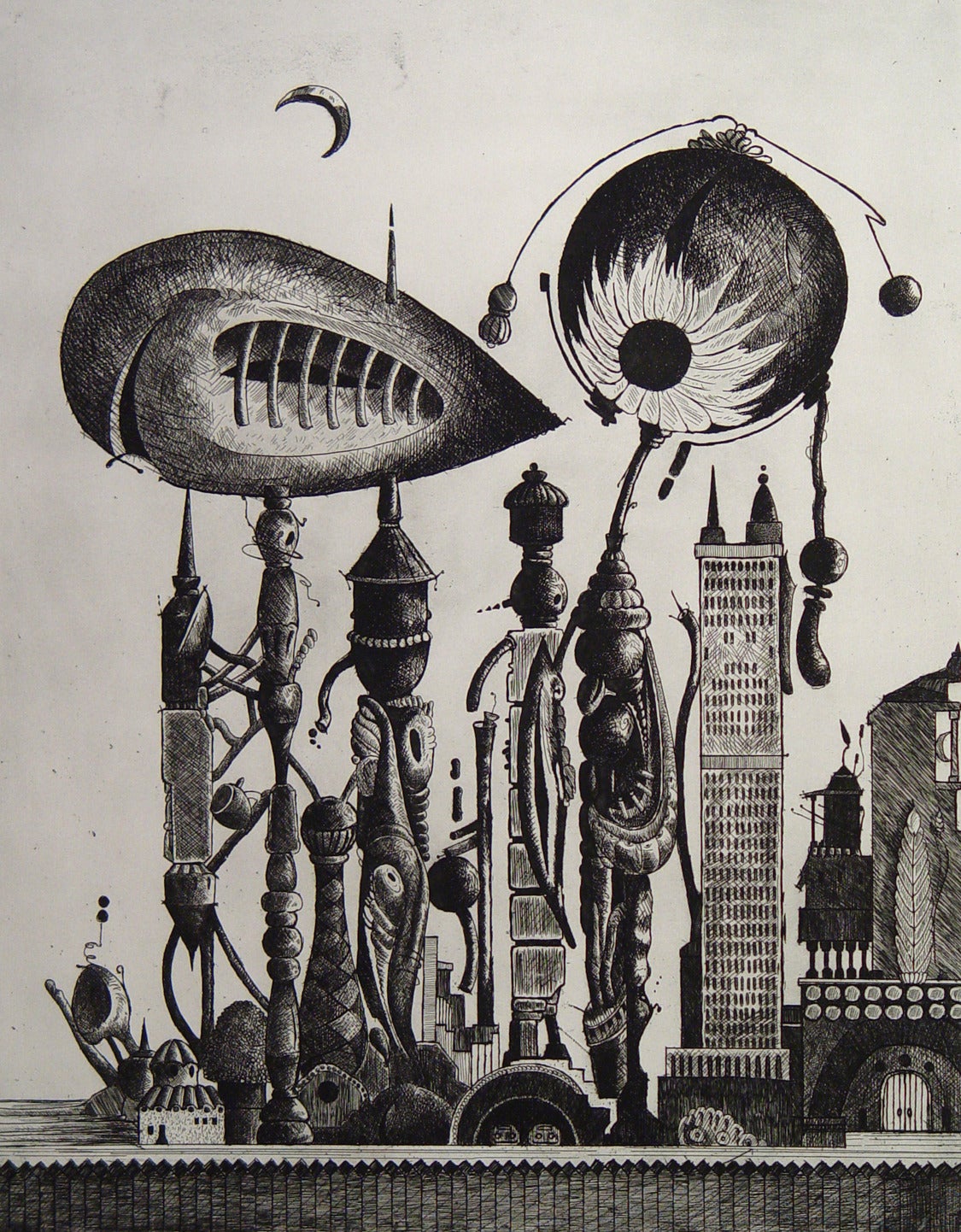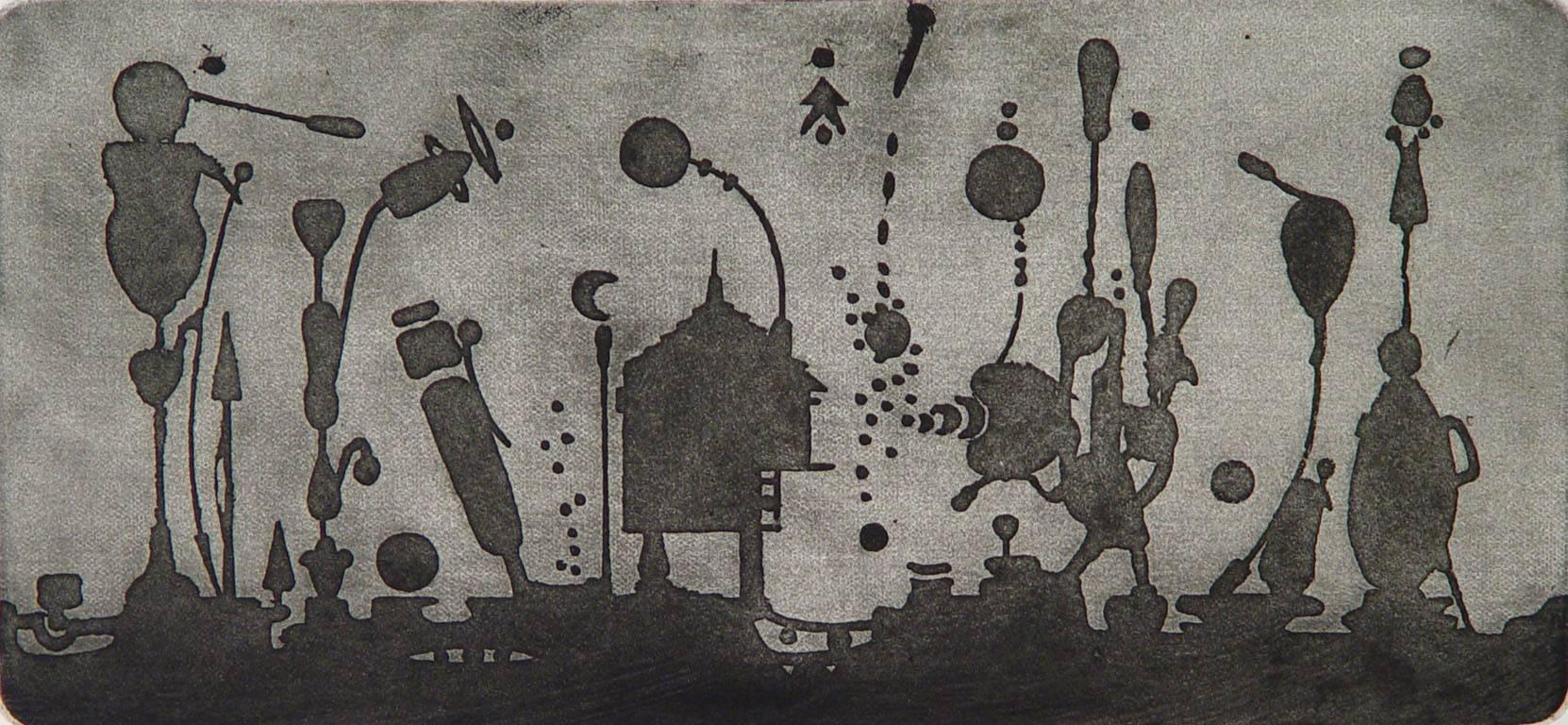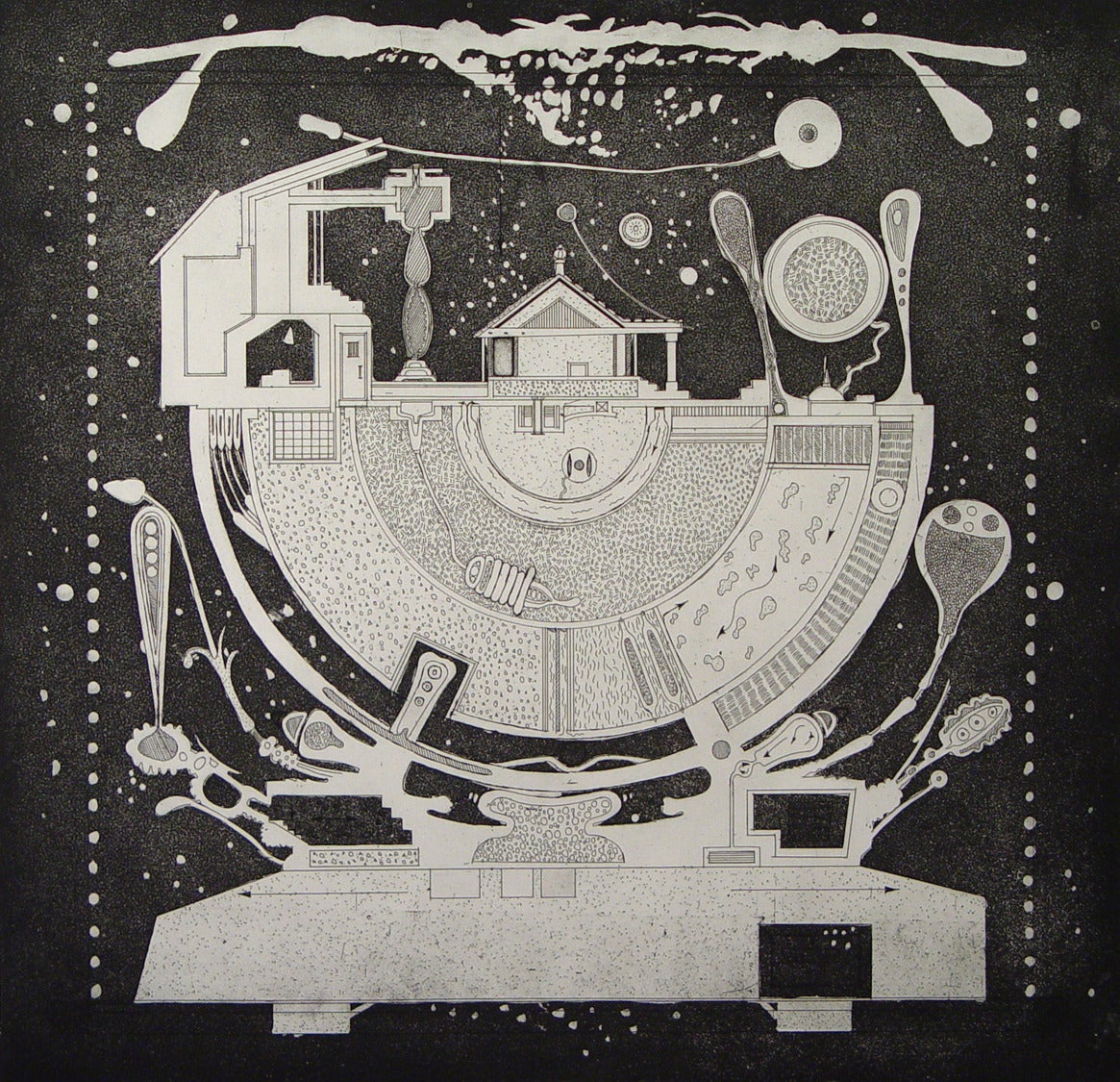Items Similar to Stop Playing and Get to Work
Want more images or videos?
Request additional images or videos from the seller
1 of 5
Valton TylerStop Playing and Get to Work1970
1970
About the Item
In The New York Times Arts in America column, Edward M. Gomez wrote of Valton Tyler, "visionary seems the right word for describing his vivid, unusual and technically refined paintings, prints and drawings, whose style defies convenient labels. Abstract, surreal, cartoonish, sci-fi fantastic, metaphysical, apocalyptic-Baroque - all of these fit but also fall short of fully describing his art." (The Living Arts, June 13, 2000, p. B2)
Valton Tyler was born in 1944 in Texas, where "the industrial world of oil refineries made a long-lasting impression on Valton as a very young child living in Texas City. He was three years old when the terrible explosion occurred there and can remember the terrifying confusion and 'the beautiful red sky and objects flying everywhere in the air.'" (Reynolds, p. 25) While growing up in Texas City, Valton's father worked in auto repair, and was known for his skill in mixing colors for paint jobs. After leaving Texas City, Valton made his way to Dallas, where he briefly enrolled at the Dallas Art Institute, but found it to be too social and commercial for his taste. After Valton's work was introduced to Donald Vogel (founder of Valley House Gallery), "Vogel arranged for Tyler to use the printmaking facilities in the art department of the Southern Methodist University in Dallas, where the young artist essentially taught himself several demanding printmaking techniques. 'It was remarkable,' Vogel says. 'Not only did he learn complicated etching methods, but he was able to express himself powerfully in whatever medium he explored.' Vogel became the publisher of Tyler's prints. Among them, the artist made editions of some 50 different images whose sometimes stringy abstract forms and more solid, architecturally arresting elements became the precursors of his later, mature style." (Gomez, Raw Vision #35, p. 36)
“Stop Playing and Get to Work” is plate number 29, and is reproduced in "The First Fifty Prints: Valton Tyler" with text by Rebecca Reynolds, published for Valley House Gallery by Southern Methodist University Press, Dallas, Texas, 1972.
In “The First Fifty Prints,” Reynolds wrote, "Valton offers a whimsical explanation of how his forms come into being in an actual construction site in 'Stop Playing and Get to Work.' The artist has explained that the machinery, work sheds, and construction supports will eventually disintegrate as the structures collect the energy necessary to float like zeppelins at the end of a fragile cord, or to bounce and send off projectiles as the finished objects on the right are now happily doing. The mysterious construction workers who Valton assures us in this title will soon be returning are left to haunt our imaginations." (Reynolds, p. 94)
Paper size: 23 1/2 x 27 1/2 inches
Edition: 5 Artists Proofs Imp. 50 Signed Prints Imp.
Bibliography:
Edward M. Gomez, "Futuristic Forms Frolic Under Eerie Texan Skies," The New York Times, June 13, 2000, page B2.
Edward M. Gomez, "Valton Tyler's Techno-Organic Landscapes," Raw Vision 35, Summer 2001, pages 34-39.
Rebecca Reynolds, "The First Fifty Prints: Valton Tyler," published for Valley House Gallery by Southern Methodist University Press, Dallas, Texas, 1972.
- Creator:Valton Tyler (1944, American)
- Creation Year:1970
- Dimensions:Height: 19 in (48.26 cm)Width: 23.75 in (60.33 cm)
- Medium:
- Movement & Style:
- Period:
- Condition:
- Gallery Location:Dallas, TX
- Reference Number:
About the Seller
5.0
Recognized Seller
These prestigious sellers are industry leaders and represent the highest echelon for item quality and design.
Established in 1954
1stDibs seller since 2013
151 sales on 1stDibs
Typical response time: Several days
Associations
Art Dealers Association of America
- ShippingRetrieving quote...Ships From: Dallas, TX
- Return PolicyA return for this item may be initiated within 2 days of delivery.
More From This SellerView All
- Avenue 11By Valton TylerLocated in Dallas, TXIn The New York Times Arts in America column, Edward M. Gomez wrote of Valton Tyler, "visionary seems the right word for describing his vivid, unusual and technically refined paintin...Category
1960s Outsider Art Abstract Prints
MaterialsRag Paper, Etching
- Together We AreBy Valton TylerLocated in Dallas, TXIn The New York Times Arts in America column, Edward M. Gomez wrote of Valton Tyler, "visionary seems the right word for describing his vivid, unusual and technically refined paintin...Category
1960s Outsider Art Abstract Prints
MaterialsRag Paper, Etching
- Just a Little Water PleaseBy Valton TylerLocated in Dallas, TXIn The New York Times Arts in America column, Edward M. Gomez wrote of Valton Tyler, "visionary seems the right word for describing his vivid, unusual and technically refined paintin...Category
1960s Outsider Art Abstract Prints
MaterialsRag Paper, Etching, Aquatint
- NeighborhoodBy Valton TylerLocated in Dallas, TXIn The New York Times Arts in America column, Edward M. Gomez writes of Valton Tyler, "visionary seems the right word for describing his vivid, unusual and technically refined painti...Category
1970s Outsider Art Abstract Prints
MaterialsPaper, Etching, Aquatint
- World of WatermelonsBy Valton TylerLocated in Dallas, TXIn The New York Times Arts in America column, Edward M. Gomez wrote of Valton Tyler, "visionary seems the right word for describing his vivid, unusual and technically refined paintings, prints and drawings, whose style defies convenient labels. Abstract, surreal, cartoonish, sci-fi fantastic, metaphysical, apocalyptic-Baroque - all of these fit but also fall short of fully describing his art." (The Living Arts, June 13, 2000, p. B2) Valton Tyler was born in 1944 in Texas, where "the industrial world of oil refineries made a long-lasting impression on Valton as a very young child living in Texas City. He was three years old when the terrible explosion occurred there and can remember the terrifying confusion and 'the beautiful red sky and objects flying everywhere in the air.'" (Reynolds, p. 25) While growing up in Texas City, Valton's father worked in auto repair, and was known for his skill in mixing colors for paint jobs. After leaving Texas City, Valton made his way to Dallas, where he briefly enrolled at the Dallas Art Institute, but found it to be too social and commercial for his taste. After Valton's work was introduced to Donald Vogel (founder of Valley House Gallery), "Vogel arranged for Tyler to use the printmaking facilities in the art department of the Southern Methodist University in Dallas, where the young artist essentially taught himself several demanding printmaking techniques. 'It was remarkable,' Vogel says. 'Not only did he learn complicated etching methods, but he was able to express himself powerfully in whatever medium he explored.' Vogel became the publisher of Tyler's prints. Among them, the artist made editions of some 50 different images whose sometimes stringy abstract forms and more solid, architecturally arresting elements became the precursors of his later, mature style." (Gomez, Raw Vision #35, p. 36) “World of Watermelons” is plate number 19, and is reproduced in "The First Fifty Prints: Valton Tyler" with text by Rebecca Reynolds, published for Valley House Gallery by Southern Methodist University Press, Dallas, Texas, 1972. Of “World of Watermelons”, Tyler said “The title here does not represent my own associations with this print. Friends simply began referring to it as ‘the watermelon print...Category
1970s Outsider Art Abstract Prints
MaterialsRag Paper, Etching, Aquatint
- Do Not TouchBy Valton TylerLocated in Dallas, TXIn The New York Times Arts in America column, Edward M. Gomez wrote of Valton Tyler, "visionary seems the right word for describing his vivid, unusual and technically refined paintin...Category
1970s Outsider Art Abstract Prints
MaterialsRag Paper, Etching, Aquatint
You May Also Like
- Process LandscapeBy Tom MarioniLocated in San Francisco, CAArtist: Tom Marioni – American (1937- ) Title: Process Landscape 1998 Year: 1998 Medium: Color spit bite aquatint Image size: 15.75 x 10 inches. Paper size: 20 x 16 inches Framed size: 21.75 x 17.75 inches Signature: Signed, dated lower right Edition: 50. This one: 24/50. Published by: Crown Point Press Printed by: Paul Mullowney Condition: Excellent Frame: Framed in maple frame and plexiglas. Frame in fair to good condition with some small scratches. Tom Marioni was born in 1937 in Cincinnati, Ohio, attended the Cincinnati Art Academy, and in 1959 moved to San Francisco, where he still lives. His first sound work, One Second Sculpture, 1969, was celebrated in the 2005 Lyon Biennial as presaging the work of many artists today who use sound and duration as subjects. His first museum show was in 1970 at the Oakland Museum of California. Titled “The Act of Drinking Beer with Friends is the Highest Form of Art,” it was an early example of social art as a sculpture action. Over the years, Marioni was invited to repeat the work in various contexts around the world. In 1970 Marioni founded the Museum of Conceptual Art (MOCA), which he described at the time as “a large-scale social work of art.” Until the museum closed in 1984, he organized many groundbreaking shows, including “Sound Sculpture As” in 1970. MOCA has entered history as one of the first alternative art spaces. Marioni had one-person shows in several significant venues for early conceptual art, among them the Richard Demarco Gallery in Edinburgh in 1972 and Gallery Foksal in Warsaw in 1975. In 1977 he had a solo show, “The Sound of Flight,” at the de Young Museum in San Francisco. He has done installation/performance works at the Whitechapel Gallery in London (1972), the Institute of Contemporary Art in London (1973), the Centre Georges Pompidou in Paris (1980), and the Folkwang Museum in Essen, Germany (1982), among other museums. He has produced sound works for radio stations KPFA in Berkeley and WDR in Cologne, Germany. In 1996 he organized The Art Orchestra and the group performed at the Legion of Honor Museum in San Francisco. Marioni was included in “For Eyes and Ears” (1980) at the Academy of Fine Arts in Berlin, “Live to Air” (1982) at the Tate Gallery in London, and “From Sound to Image” (1985) at the Stuttgart Staatsgalerie in Germany. His work was shown in “Out of Actions: Between Performance and the Object” (1998) at the Museum of Contemporary Art in Los Angeles, and “The Third Mind: American Artists Contemplate Asia,” (2009) at the Guggenheim Museum in New York City. Drawing is central to Marioni’s art, and in 1999 he had a drawing retrospective, with a catalog, at the Mills College Art Museum in Oakland. In 2006 the Contemporary Art Center in Cincinnati presented a survey of his work and published a catalog. Marioni is the author of Beer, Art and Philosophy, 2003, a memoir, also Writings on Art 1969-1999, and Fabliaux Tom Marioni Fairy Tales. He was editor/designer of VISION magazine published by Crown Point Press, 1975-1981. Issues were titled “California,” “Eastern Europe,” “New York City,” “Word Of Mouth,” (phonograph records) and “Artist’s Photographs,” and published prints, since 1974. Tom Marioni received a Guggenheim Fellowship in 1981 and three grants from the National Endowment for the Arts during the 1970s. His work is in the collections of the San Francisco Museum of Modern Art, the Museum of Modern Art in New York, the Stadtische Kunsthalle in Mannheim, Germany, the Pompidou Center in Paris, and other museums. He is represented by the Anglim Gilbert Gallery...Category
1990s Abstract Impressionist Abstract Prints
MaterialsPaper, Aquatint
- Vintage Venetian Keyhole Modernist EtchingBy Katherine Chang LiuLocated in Soquel, CAColor etching of modernist scene made up of layered images of a keyhole and entryway in Venice, Italy by California artist Katherine Chang Liu (American, 20th century). Signed "K "Li...Category
1980s Modern Abstract Prints
MaterialsPaper, Ink, Etching
- Sunrise. 1965, paper, etching, 53x52 cmLocated in Riga, LVSunrise. 1965, paper, etching, 53x52 cm Dzidra Ezergaile (1926-2013) Born in Riga. School years alternate with summer work in the countryside. In 1947, she began her studies at the ...Category
1960s Abstract Landscape Prints
MaterialsPaper, Etching
- The Monolith - Abstract Etching with Applied PaperBy Michael PaukerLocated in Soquel, CAAbstract etching with layers of indecipherable text by Michael Pauker (American, b. 1957). Tan block in the center of the piece is an applied piece of paper. This piece is an artist'...Category
1970s Contemporary Abstract Prints
MaterialsPaper, Ink, Etching
- "El Paso" Rare Contemporary Architectural Urban Landscape Etching on PaperLocated in Soquel, CARare Contemporary Architectural Urban Landscape, Artist's Proof Etching on Paper A compelling urban design of a highway underpass and one of his "El Paso: series of images, by Calif...Category
1970s Contemporary Landscape Prints
MaterialsPaper, Etching
- Contemporary Architectural Urban Landscape Etching on Paper - "The Overpass"Located in Soquel, CARare Contemporary Architectural Urban Landscape "The Overpass" Etching on Paper A compelling urban design of a highway underpass and one of his "El Paso" series of images, by Califo...Category
1970s Contemporary Landscape Prints
MaterialsPaper, Etching
Recently Viewed
View AllMore Ways To Browse
Vintage Stop
How To Send
Vintage Stop Sign Signs
Haunted Vintage
Oil Paintings Signed Reynolds
Industrial Explosion Proof
Retro Sci Fi Art Prints
Retro Sci Fi Artists
Retro Futuristic Elements
Painting Vintage Machinery
Reynolds Etching
Vintage Industrial Machinery
Southern Outsider Art
Vintage Oil Cans Collectables
Vintage Oil Cans Collectibles
Collectible Vintage Oil Cans
Haunted House
Haunted House Vintage





